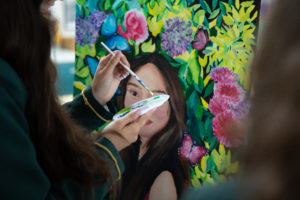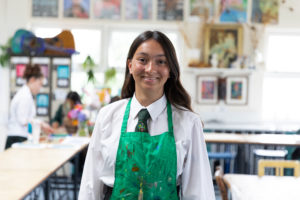Curriculum Intent

Students at SHSG are encouraged to develop an appreciation of art and design. They will acquire skills which can be refined and improved upon throughout their time at the school. They will become confident and adventurous artists who can work in a number of different styles, using a variety of techniques and materials to achieve outcomes exceeding those set out by the national curriculum. Through having ideas, exploring concepts, designing, creating and making, the students are guided to work purposefully in a positive environment to produce an original portfolio of art. They will challenge their existing expectations of themselves in order to develop individual strengths. Through taking up opportunities to study for extra qualifications and the Arts Award, students regularly become involved with societies and establishments beyond the school community, and by immersing themselves in cultural experiences students’ learning is immersive and of the highest quality. Art education at this school allows for the student artists to fully reach their potential and, most importantly, to develop a love of the subject which will stay with them long after they leave SHSG.
What does it feel like to be a student in the Art Department?

Studying art at Southend High School for Girls is an enjoyable and fulfilling experience; you will develop a deep understanding of the subject in context as well as an individual set of skills and techniques which suits your interests and abilities. This is achieved through dedication, passion and high quality teaching within the department. You will be challenged to explore and experiment with a wide range of art practices and will be encouraged to broaden your horizons both within school and outside of it. Workshops and outreach classes are organised to provide stimulation and new experiences as are residential and gallery trips which also provide inspiration for new and varied projects.
Throughout Key Stage 3 the six elements of art are embedded to create a confidence in the subject. This includes a broad and diverse introduction to the critical and contextual studies which will enhance your interest learning and skillset. A comprehensive foundation of the use of subject specific language is introduced from Year 7 and is an ongoing and important part of our curriculum.
When choosing to continue studying art in KS4 and KS5, you can be assured of your individual passion and creativity being further supported throughout your journey of realisation of intentions. Thorough advice is given with regard to foundation courses, degree courses and future career choices in the creative sector.
Opportunities throughout all key stages include competitions, public displays and exhibitions and the possibility of being submitted for both Arts Awards and extra curricular critical and contextual GCSE and A Level qualifications.
As a student of our subject you will valued supported and guided with one to one tutorials. Your teachers real passion for the art will be evident throughout your time at this school and it is hoped you will develop a life time passion for art.
Please click on the button below to download the assessment policy for Art.
